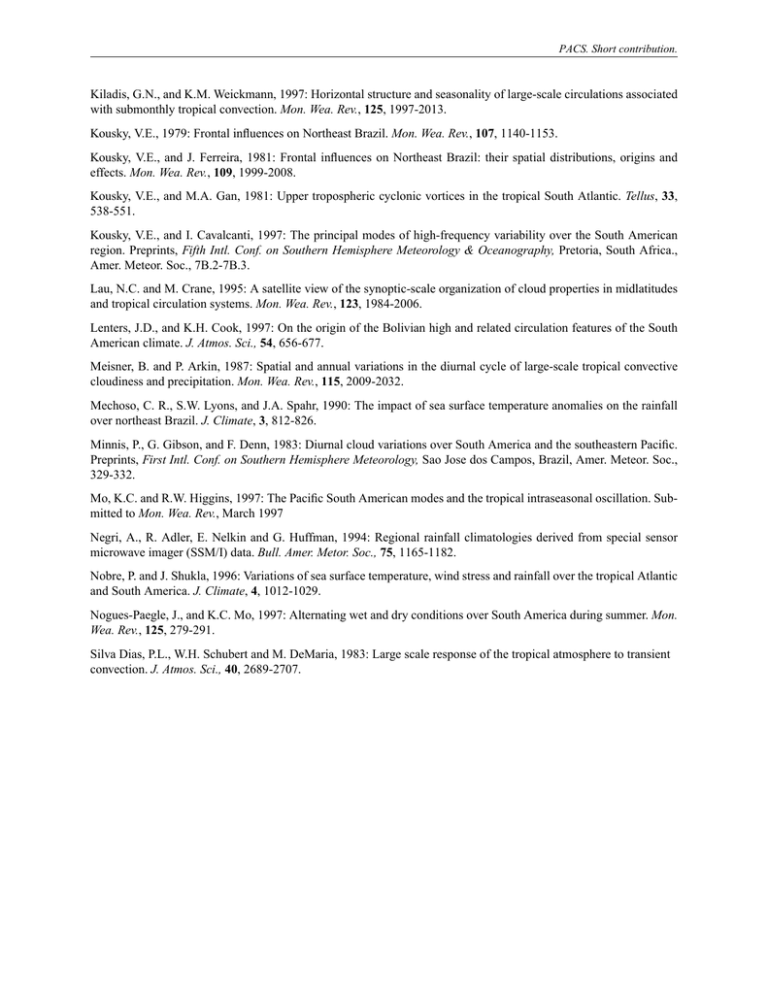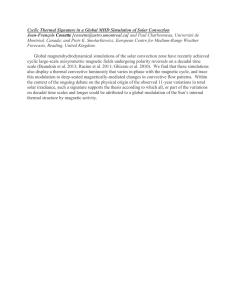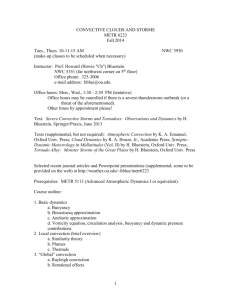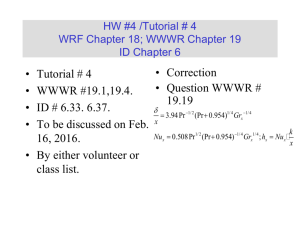Kiladis, GN, and KM Weickmann, 1997: Horizontal structure
advertisement

PACS. Short contribution. Kiladis, G.N., and K.M. Weickmann, 1997: Horizontal structure and seasonality of large-scale circulations associated with submonthly tropical convection. Mon. Wea. Rev., 125, 1997-2013. Kousky, V.E., 1979: Frontal influences on Northeast Brazil. Mon. Wea. Rev., 107, 1140-1153. Kousky, V.E., and J. Ferreira, 1981: Frontal influences on Northeast Brazil: their spatial distributions, origins and effects. Mon. Wea. Rev., 109, 1999-2008. Kousky, V.E., and M.A. Gan, 1981: Upper tropospheric cyclonic vortices in the tropical South Atlantic. Tellus, 33, 538-551. Kousky, V.E., and I. Cavalcanti, 1997: The principal modes of high-frequency variability over the South American region. Preprints, Fifth Intl. Conf. on Southern Hemisphere Meteorology & Oceanography, Pretoria, South Africa., Amer. Meteor. Soc., 7B.2-7B.3. Lau, N.C. and M. Crane, 1995: A satellite view of the synoptic-scale organization of cloud properties in midlatitudes and tropical circulation systems. Mon. Wea. Rev., 123, 1984-2006. Lenters, J.D., and K.H. Cook, 1997: On the origin of the Bolivian high and related circulation features of the South American climate. J. Atmos. Sci., 54, 656-677. Meisner, B. and P. Arkin, 1987: Spatial and annual variations in the diurnal cycle of large-scale tropical convective cloudiness and precipitation. Mon. Wea. Rev., 115, 2009-2032. Mechoso, C. R., S.W. Lyons, and J.A. Spahr, 1990: The impact of sea surface temperature anomalies on the rainfall over northeast Brazil. J. Climate, 3, 812-826. Minnis, P., G. Gibson, and F. Denn, 1983: Diurnal cloud variations over South America and the southeastern Pacific. Preprints, First Intl. Conf. on Southern Hemisphere Meteorology, Sao Jose dos Campos, Brazil, Amer. Meteor. Soc., 329-332. Mo, K.C. and R.W. Higgins, 1997: The Pacific South American modes and the tropical intraseasonal oscillation. Submitted to Mon. Wea. Rev., March 1997 Negri, A., R. Adler, E. Nelkin and G. Huffman, 1994: Regional rainfall climatologies derived from special sensor microwave imager (SSM/I) data. Bull. Amer. Metor. Soc., 75, 1165-1182. Nobre, P. and J. Shukla, 1996: Variations of sea surface temperature, wind stress and rainfall over the tropical Atlantic and South America. J. Climate, 4, 1012-1029. Nogues-Paegle, J., and K.C. Mo, 1997: Alternating wet and dry conditions over South America during summer. Mon. Wea. Rev., 125, 279-291. Silva Dias, P.L., W.H. Schubert and M. DeMaria, 1983: Large scale response of the tropical atmosphere to transient convection. J. Atmos. Sci., 40, 2689-2707. PACS. Short contribution. Figure 10. Shaded: correlation coefficient between outgoing longwave radiation (OLR) at 18°S, 70°W (central Andes), indicated by an open square, and OLR at every grid point. Contours: correlation coefficient between OLR over the central Andes and geopotential height at 200 hPa at every grid point. Contour interval is 0.2, negative contours are dashed and the zero contour is omitted. Analyses based on pentand (5-day average) data during 15 austral summer (DJF, 1979-1993) References Aceituno, P., 1989: On the functioning of the Southern Oscillation in the South America sector. Part I: Surface climate. Mon. Wea. Rev., 116, 505-524. Aceituno, P., and A. Montecinos, 1997: Patterns of convective cloudiness in South America during the austral summer from OLR pentads. Preprints, Fifth Intl. Conf. on Southern Hemisphere Meteorology & Oceanography, Pretoria, South Africa., Amer. Meteor. Soc., P4.17-18. Figueroa, N., P. Satyamurty and P.L. Silva Dias, 1995: Simulations of the summer circulation over the South American region using an eta coordinate model. J. Atmos. Sci., 52, 1573-1584. Gan, M. A. and V. Rao, 1994: The influence of the Andes cordillera on transient disturbances. Mon. Wea. Rev., 122, 1141-1157. Garreaud, R., and J.M. Wallace, 1997a: The diurnal march of convective cloudiness over the Americas. Submitted to Mon. Wea. Rev. In press (Sept. 1997). Garreaud, R., and J.M. Wallace, 1997b: Summertime incursions of mid-latitude air over tropical and subtropical South America. Submitted to Mon. Wea. Rev., May 1997. Garreaud, R., and J.M. Wallace, 1997c: Mid-latitude air incursions over tropical and subtropical South America. 22nd Climate Diagnosis Workshop. AMS, October-1997. Horel, J., A. Nahmann and J. Geisler, 1989: An investigation of the annual cycle of the convective activity over the tropical Americas. J. Climate, 2, 1388-1403. Kiladis, G.N., and K.M. Weickmann, 1992: Extratropical forcing of the tropical Pacific convection during Northern winter. Mon. Wea. Rev., 120, 1924-1937. PACS. Short contribution. Although episodic incursions of mid-latitude air are the strongest link between extratropical activity and convection over the central part of the continent, explaining most of the rainfall day-to-day variability, Southern Hemisphere mid-latitude waves may modulate the tropical and subtropical convective activity over longer periods of time by another mechanisms. Over the northeast coast of Brazil, alternating wet and dry conditions has been linked to the position of upper tropospheric cyclonic vortices meandering over the tropical South Atlantic (Kousky and Gan 1981). These long-lasting, cold cyclones are maintained throughout a direct circulation with subsidence in their centers and upward motion (and hence enhanced convection) in their perisphery. As speculated by Kousky and Gan, a key element in the vortex formation is the amplification of an upstream ridge by low level warm advection at the leading edge of a Southern Hemisphere cold front penetrating deep into the tropics. Figure 9: Composite pressure-latitude section along 60°W of equivalent potential temperature (contours, K) and meridional velocity (v,w) anomalies for day 0. The compositing analysis is based on the days with intense convection over the subtropical plains of the continent (25°S, 60°W). Thick solid line indicates area of enhanced convection. Additionally, quasi-stationary mid-latitude long-waves (wave numbers 3 or 4) over the Pacific - South America region (Mo and Higgins, 1997) may induce changes in the regional-scale pattern of moisture advection producing long periods with a tendency for wet or dry conditions over the subtropical plainsSACZ domain (Nogues-Paegle and Mo, 1997) and the central Andes (Aceituno and Montecinos 1997), where our spectral analysis reveals a significant amount of variance contained in low-frequency (10 or more days) fluctuations (Fig. 7). An example of the coupling between mid-latitude activity and subtropical convection in low-frequency time-scales is given in Fig. 10, which indicates that week-long OLR anomalies over the central Andes are associated to a wave train over the Pacific with wave-length of about 90°. It is finally argued that a further comprehending of the processes that determine the subseasonal variability of the convective activity will not only improve the short term forecast skill, but also may shed light on seasonal to interanual variability of precipitation over South America. Acknowledgments Helpful comments and discussions from Dr. Todd Mitchell are greatly appreciated. The B3 ISCCP data was provided by NASA Langley Research Center. NCAR/NCEP Reanalysis data provided trough NOAA Climate Diagnosis Center. The author is partially supported by the National Science Foundation under Grant 9215512 and by the Department of Geophysics of the Universidad de Chile. PACS. Short contribution. DAY -1 DAY 0 DAY +1 Figure 8: Composite maps of low-level wind (1000850 hPa) and IC (Wm-2, shaded) anomalies for days -1, 0 and +1. The compositing analysis is based on the days with intense convection over the subtropical plains of the continent (25°S, 60°W). Black areas indicate terrain elevation in excess of 2000 m. The influence of mid-latitude waves on the tropical convection has been documented in a more global context by Kiladis and Weickmann (1997). Midlatitude Rossby-waves can penetrate deep into the tropics in regions of upper-level westerly flow and interact with the tropical convection, particularly on sub-monthly time scales. Their specific findings over South America indicate a clear connection between disturbances originating in the Southern (northern) extratropics and convection along the eastern tip of the continent Atlantic ITCZ to the south (north) of the equator during the austral summer, in time scales from 6-30 days. In the same work, low-level southerly flow to the east of the Andes from subtropical South America emerges as a key element in the convection along the northern coast of Venezuela during June-August. Thus, the key role of extratropical disturbances forcing tropical convection over South America seems an outstanding example of a more general phenomenon, favored by the presence of the Andes mountains. PACS. Short contribution. b. Amazon Basin 1000 400 800 Power Spectra Power Spectra a. Subtropical Plains 500 300 200 100 600 400 200 0 0 10 1 10 Period [days] 0 0 10 2 10 1000 400 800 300 200 100 0 0 10 2 10 d. East coast of Brazil 500 Power Spectra Power Spectra c. Central Andes 1 10 Period [days] 600 400 200 1 10 Period [days] 2 10 0 0 10 1 10 Period [days] Figure 7. Power spectral of daily IC time series for several regions of active convection during the austral summer (DJF). Dashed lines are the red-noise spectrum (null-hypotesis) and dot-dashed lines are the 95% confidence level. Shaded bar at the bottom indicates the synoptic range. In all cases the areas encompass a 5°x5° lat/lon box centered in the following points: 27°S, 60°W (a); 12°S, 62°W (b); 19°S, 70°W (c); 10°S, 55°W (d). 2 10 PACS. Short contribution. Figure 6. Several statics of the Index of Convection (IC) during the austral summer (DJF). a: mean field. b: variance. c: variance / mean ratio. d: fraction of the variance contained in the 2-12 day range. 2000 m topographic contour is also indicated (blue lines). In the synoptic range, convective clouds are organized mainly in the form of NW-SE oriented bands, extending from the eastern slope of the Andes toward the South Atlantic, with typical transverse and longitudinal scales of 700 and 3000 km, respectively. These bands tend to develop over the subtropical plains around 35°S and move equatorward at a mean phase speed of 10 ms-1, reaching equatorial latitudes 3 or 4 days after their onset (Kousky 1979; Lau and Crane 1995; Garreaud and Wallace 1997b). Passages of these bands over the subtropical plains and southern Amazonia are observed with a frequency between 5 and 12 days during summertime, explaining up to 50% of the seasonal precipitation, and producing intense rainfall episodes. Their origin has been associated with equatorward incursions of mid-latitude air to the east of the Andes that produce intense low-level convergence at their leading edge, between the progressing southerly flow and the climatological northwesterly winds (Garreaud and Wallace 1997b). The relation between convection and tropospheric circulation is illustrated in Figs. 8 and 9 by means of a compositing analysis of IC and NCEP-NCAR reanalyzed fields. These incursions are a distinctive year-round feature of the synoptic climatology of South America (Gang and Rao 1994; Kousky and Cavalcanti 1997) forced by midlatitude waves and their subsequent interaction with the Andes (Garreaud and Wallace 1997b, 1997c). PACS. Short contribution. land ocean ocean 20 10 19 09 18 08 17 07 16 06 15 05 14 04 13 03 12 02 01 land 11 2400 1600 800 0 km inland from the mouth of the Amazon 2400 1600 800 0 km inland from the mouth of the Amazon Figure 5. Space-time section of the cloud top temperature during the first 20 days of March, 1990, inferred from 3-hourly ISCCP-B3 data. The transect is the same shown in the upper panel of Fig. 4, from the Atlantic ocean to the Amazon basin, entering the continent over the mouth of the Amazon river. The color threshold is 250K, and red colors indicate brightness temperature below 200 K. PACS. Short contribution. A’ A LAND ATLANTIC OCEAN 18 12 06 local time 00 18 12 06 00 2000 3000 Km -2000 0 1000 A’ A 5 15 25 35 45 % Figure 4. Bottom panel: Space-time section of the austral autumn (MAM) frequency of convective cloudiness (shaded, grey-scale in percentage) in transect normal to the east coast of South America, shown in the top panel. The distance is indicated with respect to the coast line (negative values over the Atlantic). Diurnal cycle is repeated twice, and local time is referred to 50°W. OLR<230 Wm-2 and 0 otherwise. The OLR dataset consists of 15-years of daily satellite observations with a 2.5° lat-lon resolution, and is produced by NOAA-NCEP. Fig. 6 includes several statics of IC during DJF. The variance field, accounting for fluctuation in the whole range of subseasonal time scales, is rather uniform and hence the variance/mean ratio is larger to the south of 25°S, indicative of more variable convective activity over the subtropical plains in comparison to the tropical sector. As shown in Fig. 6d, most of the variance over continental areas is contained in the synoptic range (2-12 days), and fluctuations between 5 and 10 days appear as a significant peak in the spectral analysis of IC over the subtropical plains and southwestern Amazon basin shown in Fig. 7. In contrast, fluctuations of longer periods (12-40 days) are more important over the eastern tip of South America and the central Andes, accounting for about half of the variance. PACS. Short contribution. To compare the amplitude of the mean diurnal cycle with respect to variability in other time-scales, Fig. 3 shows the mean evening (PM) minus morning (AM) fields of Tb, and the standard deviation of daily PM Tb. Areas of both PM and AM maximum are found over the continent and tropical oceans, but in average convective cloudiness is more prevalent and intense during evening (morning) over land (sea) [Over land, the asymmetry of the PM-AM distribution of convective cloudiness is much more marked than the PMAM difference of rainfall (Negri et al. 1994; Garreaud and Wallace 1997a) and seems to be a partial reflection of our definition of convective cloudiness]. Over areas of active convection, the typical amplitude of the diurnal cycle is 20K, roughly half of the standard deviation of the daytime Tb, and there are even regions where the mean diurnal amplitude is equal or larger than the day-to-day variability, like the northeastern coast of Brazil and the eastern subtropical plains. a. PM-AM Tb b. PM Tb standard deviation Figure 3. a: PM (2100 / 2400 UTC) minus AM (0900 / 1200 UTC) mean fields of equivalent black body temperature during DJF (K). b: Standard deviation of the PM equivalent black body temperature during DJF (K). 2000 and 4000 m topographic contours are also indicated. As an example of the diurnal march, Fig. 4 shows a space-time section of the convective cloudiness frequency in a transect from the tropical Atlantic to the Amazon basin during the austral autumn (MAM). The relevant features are the late afternoon maxima in a near-coastal band and over the Amazonia about 1500 km inland. The latter seems to be an afternoon reactivation of the landward propagating coastal convection from the previous day, perhaps associated to Amazon Coastal squall lines (Garreaud and Wallace 1997a). To further illustrate the recurrence of the mean diurnal march, Fig. 5 shows cloud top temperatures observed over the same transect of Fig. 4 during 20 days in March, 1990. Despite of day-to-day fluctuations, a significant number of days exhibit a diurnal march quite similar to the climatological (i.e., Fig. 4), with afternoon development of convective clouds near the coast and subsequent landward propagation. 3. Sub-seasonal variability In between the orderly diurnal and seasonal marches, convective rainfall exhibits irregular fluctuations in daily and weekly time-scales. In this scale, an index of deep convection (IC) is defined as 230-OLR for PACS. Short contribution. over the Americas is presented in Garreaud and Wallace (1997a), based on 3-hourly satellite observations (the ISCCP-B3 product) of outgoing longwave radiation (expressed as brightness temperature, Tb) with an spatial resolution of 0.5° lat-lon. On the basis of convective cloudiness frequencies at 0000, 0300,..., 2100 UTC during the austral summer, Fig. 2 shows the daily mean and standard deviation of the convective cloudiness frequency. Fig. 2 also presents the convective cloudiness frequency for late afternoon and early morning. These analyses document enhanced convection near regional features, such as mountain ranges and concave coastlines, as well as a banded structure over the Amazon basin, also evident in the austral autumn (MAM). The afternoon/evening maximum over most of the continent, documented in previous studies (e.g., Minnis et al. 1983; Meisner and Arkin 1987), is consistent with the more conducive thermodynamic conditions during this part of the day, while the distinctive spatial pattern is suggestive of localwind systems and dynamical forcing from remote convection playing an important role in the distribution of convective cloudiness. Figure 2. a: Daily mean frequency of convective cloudiness (Tb<235K) during DJF. b: Diurnal standard deviation of the 3-hourly frequency of convective cloudiness during DJF. c: Frequency of convective cloudiness at 2100 UTC (PM conditions) during DJF. d: Frequency of convective cloudiness at 1200 UTC (AM conditions) during DJF. Based on 3-hourly ISCCP-B3 satellite data. See Garreaud and Wallace (1997a) for details. PACS. Short contribution. DEC-JAN JUN-JUL FEB-MAR AUG-SEP APR-MAY OCT-NOV 180 190 200 210 220 230 240 250 260 Figure 1: Bi-monthly means of outgoing longwave radiation (Wm-2) over the Americas. PACS. Short contribution. High Frequency Variability of South American Convective Rainfall René D. Garreaud Joint Institute for the Study of the Atmosphere and Ocean University of Washington, Seattle, WA 1. Introduction Most of the rainfall over South America is produced by tropical or warm-season mid-latitude deep cumulus convection, with the exception of the southern tip of the continent and its subtropical west coast where cold fronts are the leading rain producers. Following the annual march of the insolation the area of intense thunderstorms exhibits a regular north-south migration over the Americas, as shown in Fig.1 by the bimonthly mean fields of outgoing longwave radiation (OLR). The extensive area of convective cloudiness, indicated by blue to red shading (OLR < 230 Wm-2), reaches its southernmost position during the austral summer months, December, January and February (DJF), when it covers most of the central and southern Amazon basin, the central Andes, and a portion of the subtropical plains of the continent. Both the onset and demise of the so-called South American Monsoon occurs as a rapid shift of the area of intense convection between the northwestern extreme of the continent and latitudes south of the equator, around mid October and May, respectively (Horel et al. 1989). Superimposed on the annual cycle, continental precipitation exhibits fluctuations in a broad and quasi-continuous spectrum of temporal and spatial scales, from the diurnal march to interanual variability and beyond. Regional phenomena of different scales are strongly coupled among themselves; influenced by mountain ranges, coastline geometry and boundary conditions (e.g. SST, soil moisture); and teleconnected by atmospheric variability to other regions of the globe. The understanding of South American climate and weather has significantly increased in the last decades, based on both observational and modeling studies. These studies have mainly focused on climatological aspects and interannual variability (e.g., Horel et al. 1989; Aceituno 1989; Mechoso et al. 1990; Nobre and Shukla 1996), and most of the modeling work have attempted to simulate the summertime tropospheric circulation and its association with the convection (e.g., Silva Dias et al. 1983; Figueroa et al. 1995; Lenters and Cook 1997). In contrast, the observational picture of daily to weekly variability is much less comprehensive, and is scattered in a number of local case studies. In this context, the main objective of the present contribution is to summarize the key large- and regional-scale atmospheric processes responsible for fluctuations of the continental precipitation on sub-seasonal time-scales. 2. The diurnal march Convective cloudiness exhibits a well defined diurnal cycle tied to the diurnal march of the insolation and influenced by regional factors. This fluctuation is particularly relevant over the tropics, where synoptic variability is weak, and it has a clear signature in the rainfall climatology. A detailed picture of the climatological diurnal march of the convective cloudiness (defined by a cloud top temperature less than 235K)





